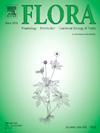土壤微生物群和原生邻居身份影响入侵植物的竞争力
IF 1.8
4区 生物学
Q3 ECOLOGY
引用次数: 0
摘要
入侵植物经常与本地物种竞争,从而改变本地生态系统的结构和功能。土壤微生物群可以通过对植物性能的影响进一步影响入侵结果,但尚不清楚土壤微生物群和原生邻居身份如何共同塑造这些竞争动态。本研究利用自然土壤和无菌土壤,分离了外来入侵植物Alternanthera philoxeroides (amaranaceae)与两种本土植物Bidens bipinnata (Asteraceae)和Setaria viridis (Poaceae)之间的生物和非生物效应,并对其竞争进行了研究。研究了不同土壤处理下植物生长性能及其相互作用关系。除去土壤微生物群后,与绿芽孢杆菌竞争时,入侵菌的总生物量降低,且与绿芽孢杆菌一起生长时,其生物量低于单独生长或在无菌土壤中与双峰双叶草一起生长时。无论土壤处理如何,与任何一种本地物种的竞争都增加了入侵植物的根冠比,而灭菌则增加了竞争下的比叶面积。此外,土壤微生物群和邻居身份都影响着入侵植物的相互作用关系和竞争强度。自然土壤削弱了入侵植物与绿刺草的竞争相互作用,降低了入侵植物与双羽石竹的竞争强度。对本土种而言,与外来入侵植物竞争时,绿草的茎部生物量、总生物量和根冠比均有所增加,而石裙楠的反应不明显。总体而言,我们的研究结果表明,土壤微生物群和邻居身份共同调节入侵植物的竞争能力,强调它们在形成入侵结果中的重要性。本文章由计算机程序翻译,如有差异,请以英文原文为准。
Soil microbiota and native neighbor identity affect invasive plant competitiveness
Invasive plants often compete with diverse native species, thereby altering native ecosystem structure and function. Soil microbiota can further influence invasion outcomes through their effects on plant performance, yet it remains unclear how soil microbiota and native neighbor identity jointly shape these competitive dynamics. Here, we used natural and sterilized soil to separate biotic from abiotic effects and examined competition between the invasive Alternanthera philoxeroides (Amaranthaceae) and two native species, Bidens bipinnata (Asteraceae) and Setaria viridis (Poaceae), in a common garden experiment. We assessed plant performance and their interaction relationship under different soil treatment. Soil microbiota removal reduced the invader’s total biomass when competing with S. viridis, and its biomass was lower with S. viridis than when grown alone or with B. bipinnata in sterilized soil. Competition with either native species increased the invader’s root-shoot ratio regardless of soil treatment, while sterilization enhanced its specific leaf area under competition. Moreover, both soil microbiota and neighbor identity influenced interaction relationship and competition intensity of the invader. Natural soil weakened the competition interaction and reduced the competition intensity between invasive plant and S. viridis, but not with B. bipinnata. For the native species, S. viridis showed increased shoot biomass, total biomass, and root-shoot ratio when competing with invader, while B. bipinnata showed no significant response. Overall, our findings demonstrate that soil microbiota and neighbor identity jointly regulate the competitive ability of invasive plants, underscoring their importance in shaping invasion outcomes.
求助全文
通过发布文献求助,成功后即可免费获取论文全文。
去求助
来源期刊

Flora
生物-植物科学
CiteScore
3.30
自引率
10.50%
发文量
130
审稿时长
54 days
期刊介绍:
FLORA publishes original contributions and review articles on plant structure (morphology and anatomy), plant distribution (incl. phylogeography) and plant functional ecology (ecophysiology, population ecology and population genetics, organismic interactions, community ecology, ecosystem ecology). Manuscripts (both original and review articles) on a single topic can be compiled in Special Issues, for which suggestions are welcome.
FLORA, the scientific botanical journal with the longest uninterrupted publication sequence (since 1818), considers manuscripts in the above areas which appeal a broad scientific and international readership. Manuscripts focused on floristics and vegetation science will only be considered if they exceed the pure descriptive approach and have relevance for interpreting plant morphology, distribution or ecology. Manuscripts whose content is restricted to purely systematic and nomenclature matters, to geobotanical aspects of only local interest, to pure applications in agri-, horti- or silviculture and pharmacology, and experimental studies dealing exclusively with investigations at the cellular and subcellular level will not be accepted. Manuscripts dealing with comparative and evolutionary aspects of morphology, anatomy and development are welcome.
 求助内容:
求助内容: 应助结果提醒方式:
应助结果提醒方式:


